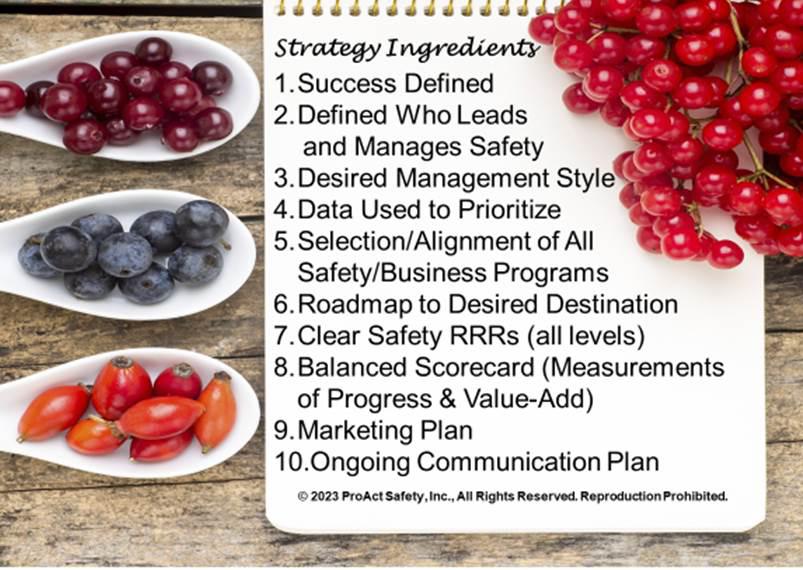March 13 2023
By: Shawn M. Galloway
I've developed and reviewed more safety strategies than anyone. Also, because of the two books Terry Mathis and I wrote on the subject, hundreds of leaders requested our help in reviewing their current safety strategy and providing feedback. Most are missing an essential ingredient or two. Review the following ingredients and see if your strategy is complete.
 Success Defined - It must be clear who the customer is and what success and the destination will look like in results and cultural terms; otherwise, everyone will be left to individually define what path they take and what it looks like when they arrive. For culture, what would be shared (i.e., beliefs, behaviors, competencies, knowledge, experiences, language, stories) when great results are sustainable?
Success Defined - It must be clear who the customer is and what success and the destination will look like in results and cultural terms; otherwise, everyone will be left to individually define what path they take and what it looks like when they arrive. For culture, what would be shared (i.e., beliefs, behaviors, competencies, knowledge, experiences, language, stories) when great results are sustainable?
Defined Who Leads and Manages Safety - One cannot delegate a core value. If the strategy includes driving safety from a perceived priority to value, you must define what the specific injury-prevention and culture-enhancing roles, responsibilities, and observable results are. Do the leaders lead and manage safety, or is it driven by the safety professional?
Desired Management Style - What is needed from those in leadership positions? Does drastic change need to occur rapidly, or is the goal employee involvement and ownership? What style of management and leadership is required? A strategy to meet aggressive regulatory compliance is much different than one focusing on a culture of excellence. Styles will evolve but should be situational for what is needed at the time.
Data Used to Prioritize - Data should set a strategy with limited input from opinions. Data should also be available to provide insights on where to focus your efforts: Conditions, Compliance, Capital, Culture, Complete Person, Confidence in System Capacity, Competency EHS Technical Acumen and Competency Leadership Acumen.
Selection/Alignment of All Safety/Business Programs - Effective strategy requires fit and alignment among the organization's many activities, goals and plans. Safety should never compete with production; it should add value to it and those impacted by the efforts. What programs or activities do you need to start, modify or stop? What creates the perception of complementary versus conflicting? Does the safety strategy support or hinder the overall business strategy?
Roadmap to Desired Destination - If people cannot see where the organization is going, what it will look like when they get there, and how to decipher where they are on the journey, expect confusion and minimal discretionary effort.
Clear Safety RRRs (all levels) - Everyone must see themselves as actors in the safety strategy. They must know their part. To support the execution of the strategy and achieve the desired end-state or vision, there must be clear Safety Roles, Responsibilities, and Results listed for the many levels within the company, but customized to what is needed and driven by insights from data.
Balanced Scorecard (Measurements of Progress and Value-Add) - Lagging, leading, and transformational or value-based measurements must exist. Visible progress towards a goal is an effective motivator, so ensure your strategy provides it. Further, it must continue to answer the "what's in it for me" question that never goes away. Those impacted by the strategy should be able to name two or three wins from the strategy and how it specifically benefits them or their roles personally.
Marketing Plan - For discretionary effort, you must compete for attention; thus, you need a marketing plan. How will you brand your strategy? How will you position that brand? How will you capture the voice of the customer to ensure value-add, and how will you reinforce the decision to buy in afterward?
Ongoing Communication Plan - Communication is a process, not an event, and it is known that one of the primary reasons for resistance to change is people don't understand the reason for the change. Organizations that tend to outperform others do so with highly engaged employees who feel like they know the company strategy and their evolving role within it.
A few years ago, in response to the significant response to our strategy work, we created a tool for leaders to self-assess the efficacy of their safety strategy. To request a copy of this tool, email info@proactsafety.com with the subject Strategy Self-Assessment Tool.
"Strategy is not the consequence of planning, but the opposite: its starting point." — Henry Mintzberg
"A goal without a plan is just a wish." — Antoine de Saint-Exupéry
"There is nothing so useless as doing efficiently that which should not be done at all." — Peter Drucker

Shawn M. Galloway is the CEO of ProAct Safety and an advisor to leading organizations across all major industries. With over twenty years of experience in safety systems, strategy, culture, leadership, and employee engagement, he is a trusted advisor, keynote speaker, and expert witness.
He is the author of several bestselling books and has multiple regular columns in leading magazines, with over 400 articles and 100 videos to his credit. He also created the first safety podcast, Safety Culture Excellence, with over 800 episodes. Shawn has received numerous prestigious accolades and has been featured in Power 101 Leaders of the EHS World, Top 50 People Who Most Influenced EHS, Top 40 Rising Stars, Top 11 Health and Safety Influencers, and Top 10 Speakers.
He serves on the Harvard Business Review Advisory Council and the Fast Company Executive Board. He has appeared as a guest on Bloomberg, Fox News, The Daily Mail, Dubai One, U.S. News & World Report, Sirius Business Radio, Wharton Business Daily, and leading safety magazines and podcasts, reinforcing his status as an authority in the field of safety excellence.
For more information, call +1.936.273.8700 or email info@ProActSafety.com.
